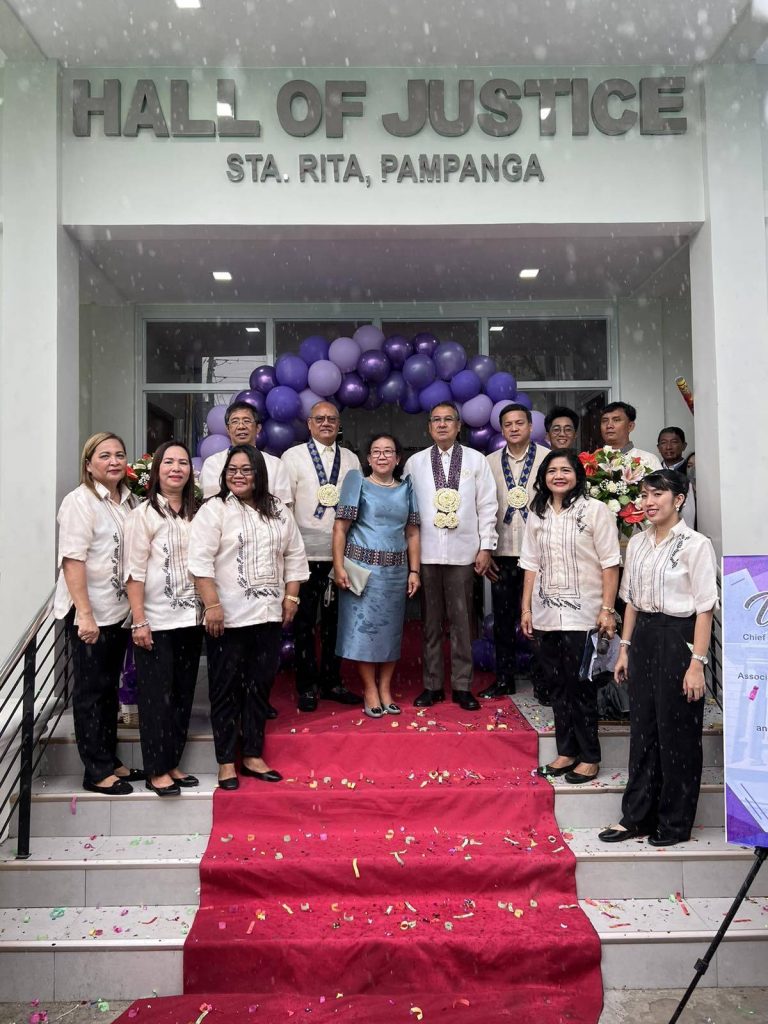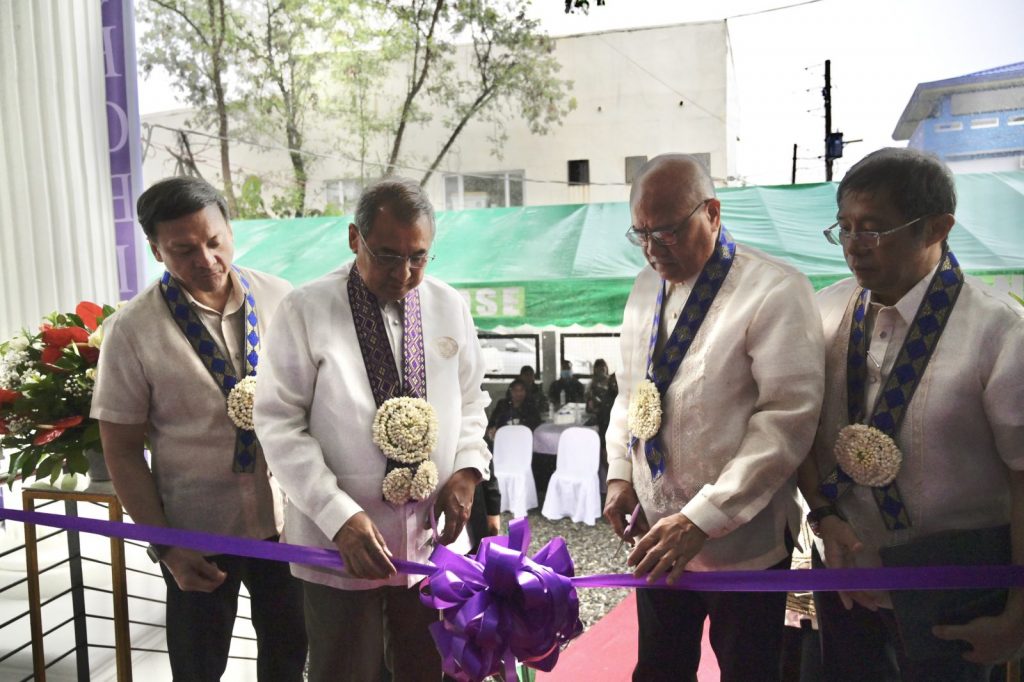Chief Justice Gesmundo Leads Inauguration of Sta. Rita, Pampanga HOJ
July 28, 2023

Chief Justice Alexander G. Gesmundo (back row, fourth from left), together with (back row, from left) Court Administrator Raul B. Villanueva, Sta. Rita, Pampanga Mayor Arthur L. Salalila, Sta. Rita, Pampanga Municipal Trial Court (MTC) Judge Maria Zenaida V. Ferrer-Alejandre, and Associate Justice Jose Midas P. Marquez, leads the inauguration of the newly constructed Hall of Justice of Sta. Rita, Pampanga on July 26, 2023. With them are the personnel of the Sta. Rita, Pampanga, MTC. Not in picture is Pampanga Vice Governor Lilia G. Pineda, who also graced the event. (Courtesy of the Supreme Court Public Information Office)
“Ang araw na ito ay nagpapatunay ng isang bagay—Pagká ang mga empleyado, kawani, opisyal ng gobyerno ay nagkaisa, lalong lalo na ‘pag sumuporta ang local government unit, lahat ay matatamo. Hindi ito milagro. Ito ay gawa natin. Sa pagkakaisa, pagtutulungan, lahat ay magiging posible.”
Thus, said Chief Justice Alexander G. Gesmundo, as he spoke at the inauguration of the newly constructed Hall of Justice (HOJ) of Sta. Rita, Pampanga on July 26, 2023.
“The geography of this municipality and the occasion that brings us here today strike me as an apt reminder: justice forms the heart of our society. It is what binds us together. The stability it provides is what allows us to coexist as a community, as a country, and serves as the foundation of our shared pursuit of progress,” said the Chief Justice in Kapampangan, adding that if justice is not dispensed efficiently and effectively, the consequences are catastrophic.
Chief Justice Gesmundo expressed that while the inauguration of the Sta. Rita HOJ may be a milestone, the occasion serves to refocus the Judiciary’s efforts in the task of addressing the longstanding problem of making justice not only accessible, but also speedy and inexpensive, in line with the Court’s Strategic Plan for Judicial Innovations 2022-2027 (SPJI), which was launched last year.
“I know I have discussed the SPJI and its target outcomes and corresponding activities at length on previous occasions with judges and court employees,” said the Chief Justice. “But I mention it again to emphasize: building the justice system we envision involves so much more than brick and mortar. It calls on us to innovate and improve not just our physical structures but our processes and systems as well, in order to make them more responsive and accessible to the people we serve,” he added.
The Chief Justice likewise thanked all the agencies, offices, and individuals who were instrumental in the construction of the Sta. Rita HOJ.
“Kaya nagpapasalamat ako sa lokal na government ng Sta. Rita, Pampanga na nagbigay ng lupa para maitayo ang korteng ito. Nagpapasalamat ako sa ‘nanay’ ng Pampanga, Vice Governor Lilia Pineda, who has been always supporting the judiciary’s activities in the province of Pampanga,” said Chief Justice Gesmundo.
In his opening remarks, Court Administrator Raul B. Villanueva underscored that “having a presentable and reputable hall of justice emphasizes the lofty place that our justice system has in our democratic order.” He added: “We live in a society where law and order are supreme, where the rule of law governs, and justice should be dispensed with impartially, fairly, and expeditiously.”
Court Administrator Villanueva also expressed hope that the new Sta. Rita HOJ will serve as a constant reminder to all its users that they all have a huge role to play in the judicial system. “We in the judiciary should not fail the expectations of the people in Sta. Rita…Instead, we should serve them well with utmost passion and dedication,” said the Court Administrator.
He stressed that the Sta. Rita HOJ is more than just a structure. “It symbolizes the firm resolve of our institution in serving justice to those who come to us for relief. We, therefore, should maintain at all times its integrity and eminence,” he said.
Sta. Rita, Pampanga MTC Presiding Judge Maria Zenaida V. Ferrer-Alejandre, in her welcome remarks, narrated the history behind the construction of the HOJ, and expressed her gratitude to the Municipality of Sta. Rita for having accommodated the Sta. Rita MTC in different locations since the 1950s; to the Sta. Rita local government, for donating the land on which the Sta. Rita HOJ stands; and to the Office of the Court Administrator – Office on the Halls of Justice, for the construction of the Sta. Rita HOJ.
“For us judges, a separate HOJ building provides us with an additional sense of pride, dignity, and security,” said Judge Ferrer-Alejandre.
Also gracing the event were Associate Justice Jose Midas P. Marquez; Assistant Court Administrator and Public Information Office Chief Brian Keith F. Hosaka; OCA-Office on the Halls of Justice Chief Atty. Raquel M Ladrillano; Pampanga Vice Governor Lilia G. Pineda; and Sta. Rita, Pampanga Mayor Arthur L. Salalila.
After the inauguration, Chief Justice Gesmundo, Justice Marquez, and Court Administrator Villanueva proceeded to the Guagua, Pampanga HOJ for a dialogue with first- and second-level trial court judges of Pampanga to share with the latter updates on the judicial reform projects under the SPJI as well as to listen to and answer their concerns. (Courtesy of the Supreme Court Public Information Office)

Chief Justice Alexander G. Gesmundo (second from left) and Sta. Rita, Pampanga Mayor Arthur L Salalila cut the ceremonial ribbon to formally inaugurate the Hall of Justice of the Sta. Rita, Pampanga Municipal Trial Court on July 26, 2023. Looking on are (from left) Associate Justice Jose Midas P. Marquez and Court Administrator Raul B. Villanueva. (Courtesy of the Supreme Court Public Information Office)












